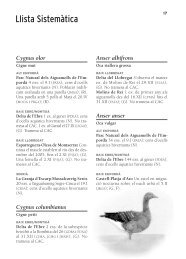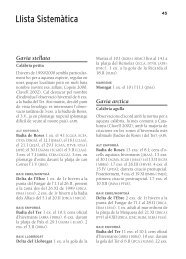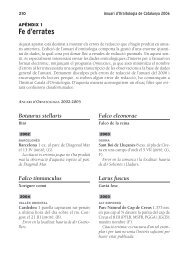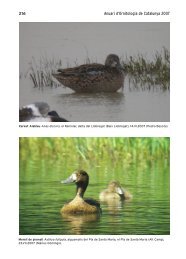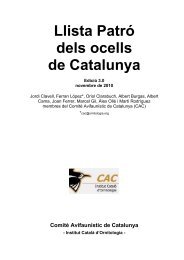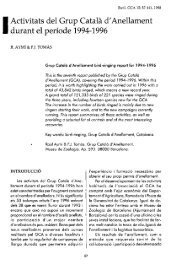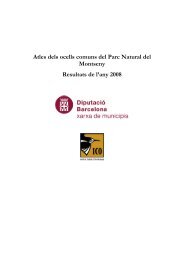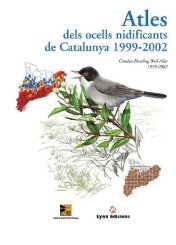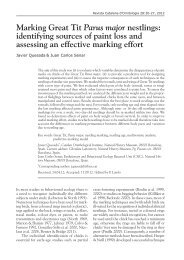I Dades sobre la muda de la terretitona Calidris minuta a Mallorca ...
I Dades sobre la muda de la terretitona Calidris minuta a Mallorca ...
I Dades sobre la muda de la terretitona Calidris minuta a Mallorca ...
Create successful ePaper yourself
Turn your PDF publications into a flip-book with our unique Google optimized e-Paper software.
The inci<strong>de</strong>nce of suspen<strong>de</strong>d moult, like<br />
the duration of postnuptial moult, is closely<br />
re<strong>la</strong>ted to the ecological conditions affecting<br />
the annual life cycle of the bird (Ginn &<br />
Melville 1983, Pearson 1984). In Morocco,<br />
Pienkowski et al. ( 1 976) only found one out<br />
of 273 birds in suspen<strong>de</strong>d moult, but Pearson<br />
(1 984) pointed out that, although it was<br />
rare amongst birds aniving at his study area<br />
in Kenya, he found it very commonly among<br />
birds un<strong>de</strong>rgoing their postnuptial moult<br />
there. Such differences, and the fact that the<br />
duration of the postnuptial moult in Kenya is<br />
more than twice as long as in Morocco,<br />
show that the suspension of moult could work<br />
as a mechanism to prolong the duration of<br />
moult, presumably in or<strong>de</strong>r to prevent the<br />
energetic <strong>de</strong>mands for mouh exceeding, in<br />
some moments, those that the bird can meet<br />
(Pearson 1984).<br />
The inci<strong>de</strong>nce of moult suspension re<br />
cor<strong>de</strong>d in the present study does not seem to<br />
be re<strong>la</strong>ted to a strategy of prolongation of<br />
~ostnu~tial moult. The ambient conditions<br />
jtemgeiature and sun hoursl in the Balearic<br />
hinter are still tougher than those in Morocco<br />
and much worse than those in Kenya (GOB<br />
19901. Wa<strong>de</strong>rs from northern winterina U<br />
grounds avoid moulting during the stressful<br />
mid-winter, when the feeding conditions are<br />
poor (GossCustard 1969, Pearson 1984,<br />
Zwarts et al. 19901. The high inci<strong>de</strong>nce of<br />
suspen<strong>de</strong>d moult found in this study and the<br />
low proportion of birds in active moult (of<br />
those that had not finished), with such a low<br />
number of feathers growing simultaneously,<br />
seem to be the answer to such restrictions<br />
uanuary and February are the col<strong>de</strong>st months<br />
in Maiorca, GOB 1990). Suspen<strong>de</strong>d moult<br />
in northern wintering areas would be part of<br />
a moult strategy to avoid a waste of energy,<br />
due to moult, during the stressful mid-winter<br />
period. The thermal im~rovement after midwinter<br />
could be the stariing point for the completion<br />
of postnuptia/ moult in wintering birds.<br />
In re<strong>la</strong>tion to the completion of primary<br />
moult we can find two different groups: birds<br />
Muda <strong>de</strong> <strong>la</strong> Terretitona<br />
in a suspen<strong>de</strong>d middle stage of moult com-<br />
pletion; and birds finishing or with moult<br />
finished. Although few birds were examined,<br />
the popu<strong>la</strong>tion studied might consist of two<br />
groups with different phenology or moulting<br />
areas, or both.<br />
In the present study we did not find any<br />
first winter birds rnou/ting primaries or se-<br />
condaries, but they moult to varying extents<br />
some terfials (Table I j. The tertial moult pat-<br />
tern follows the same pattern as in many<br />
other species, with a ten<strong>de</strong>ncy to moult the<br />
innermost ones; in this wav birds renew the<br />
most important'feathers fo; the protection of<br />
physical and thermal body iso<strong>la</strong>tion (Gauci<br />
& Sultana 1979, Mester & Prünte 1982,<br />
Gargallo pers.obs.). Some birds might mi-<br />
grate further south to moult, but most birds<br />
Jeem to remain wintering, as we have se<br />
veral controls of our birds from <strong>la</strong>te Decem-<br />
ber and january (7 out of 2 1 j.<br />
BIBLIOGRAFIA<br />
CRAMP,S & SIMMONS,K.E.L<br />
(eds.). 1983. The Birds of the Western Palearctic.<br />
Vol I. Oxford: Oxford University<br />
Press.<br />
GAUCI,C. & SULTANAJ. 1979. Moult<br />
of the Sardinian Warbler. 11-Merill 20: 1-1 3.<br />
GINN, H.B & MELVILLE, D.S. 1983.<br />
Moult in birds. BTO Gui<strong>de</strong> 19. BTO. Tring.<br />
GOB. 1990. Anuari ornitol6gic <strong>de</strong> les<br />
Balears, 1989. Palma: GOB.<br />
GOSS-CUSTARD, J.D. 1969. The winter<br />
feeding ecology of the Redshank (Tringa to<br />
tanus). Ibis 1 1 1 :338-356.<br />
MESTER, H. & PRUNTE, W. 1982. Die<br />
"sektorale" postiuvenile Handschwingen-<br />
mauser <strong>de</strong>r Carduelinen in Sü<strong>de</strong>uropa. Jour-<br />
nal fur Ornithologie 1 23: 38 1-399.




